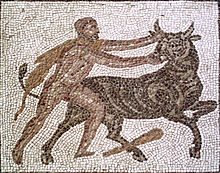- Cretan Bull
-
Cretan Bull 
Heracles capturing the Cretan Bull. Detail of a Roman mosaic from Llíria (Spain).Mythology Greek mythology Grouping Legendary creature Country Greece Region Crete Similar creatures Minotaur In Greek mythology, the Cretan Bull was either the bull that carried away Europa or the bull Pasiphaë fell in love with, giving birth to the Minotaur.
Contents
Origin
When the sun has reached the constellation of Taurus, it has passed over an area that the ancients referred to as the sea - the region from Capricorn to the region containing Aries. It was referred to as the sea due to the high concentration of constellations identified as sea creatures within it, Aries being identified as a golden flying ram who flew over the sea. Crete is in a direct line from the natural harbor of Argo, a direction which due the shape of Argo's harbor, and surrounding coastline, requires that all ships initially take this course.
Apart from being a bull, Taurus contains a very bright and red star (Aldebaran), meaning that many took it to be evil. Some forms of Greek mythology associated the constellation with the tame white bull, in some versions Zeus in disguise, that seduced Europa and took her to Crete (Minos), whereas others associate it with the white bull that fathered the Minotaur. The Cretan Bull which fathered the Minotaur was originally calm and sent from Poseidon, but king Minos whom it was sent to fell out of favor with Poseidon, and so in some versions of the story, Poseidon made the bull angry.
The myth of Poseidon sending the bull (which seduced Minos' wife) may simply be an earlier version of the myth of Zeus seducing Europa, as in earlier Mycenean times, Poseidon had significantly more importance than Zeus. The change of gods was due to the replacement of the Mycenean culture and religion, with a later one favoring Zeus. Poseidon and Zeus, which have the same etymological origin (Poseidon deriving from Posei-Deion which means Lord God[citation needed], and Zeus deriving from Deus which also means God[citation needed]), may be the result of the parallel evolution of the same original god in separate cultures, one (Poseidon - who is also associated with horses) becoming associated more with the sea (due to change in the main source of trade), and thus eventually becoming noticeably different.
The Seventh Labour of Heracles
Whistling merrily at his success so far, Heracles was then sent to capture the bull by Eurystheus as his seventh task. He sailed to Crete, whereupon the King, Minos, gave Heracles permission to take the bull away and offered him assistance, which Heracles denied because of pride,[1] as it had been wreaking havoc on Crete by uprooting crops and leveling orchard walls. Heracles snuck up behind the bull and then used his hands to strangle it, and then shipped it back to Athens. Eurystheus, who hid in his pithos at first sight of the creature, wanted to sacrifice the bull to Hera, who hated Heracles. She refused the sacrifice because it reflected glory on Heracles. The bull was released and wandered into Marathon, becoming known as the Marathonian Bull.[1] Theseus would later sacrifice the bull to Athena and/or Apollo. Eurystheus then sent Heracles to bring back the man-eating Mares of Diomedes.
Capture by Theseus
Androgeus, a son of Minos and Pasiphaë, competed in the games held by Aegeus, King of Athens. He won all the games, so angering Aegeus that he had the young man killed (some legends claim that he was sent to confront the Bull itself). Devastated, Minos went to war with Athens and won. As punishment, the Athenians had to send several youths every year to be devoured by the Minotaur.
Aegeus' own son, Theseus, set to try to capture the Bull. On the way to Marathon, Theseus sought shelter from a storm in the shack owned by an ancient lady named Hecale. She swore to make a sacrifice to Zeus if Theseus was successful in capturing the bull. Theseus did capture the bull, but when he returned to Hecale's hut, she was dead. Theseus built a deme in her honor. He then dragged the Bull to Athens where he sacrificed it.
Theseus then went to Crete where he killed the Minotaur with the help of Minos' daughter Ariadne.
References
See also
Categories:- Labors of Hercules
- History of Crete
- Greek legendary creatures
- Mythological bovines
- Greek mythology
- Labors of Theseus
Wikimedia Foundation. 2010.

